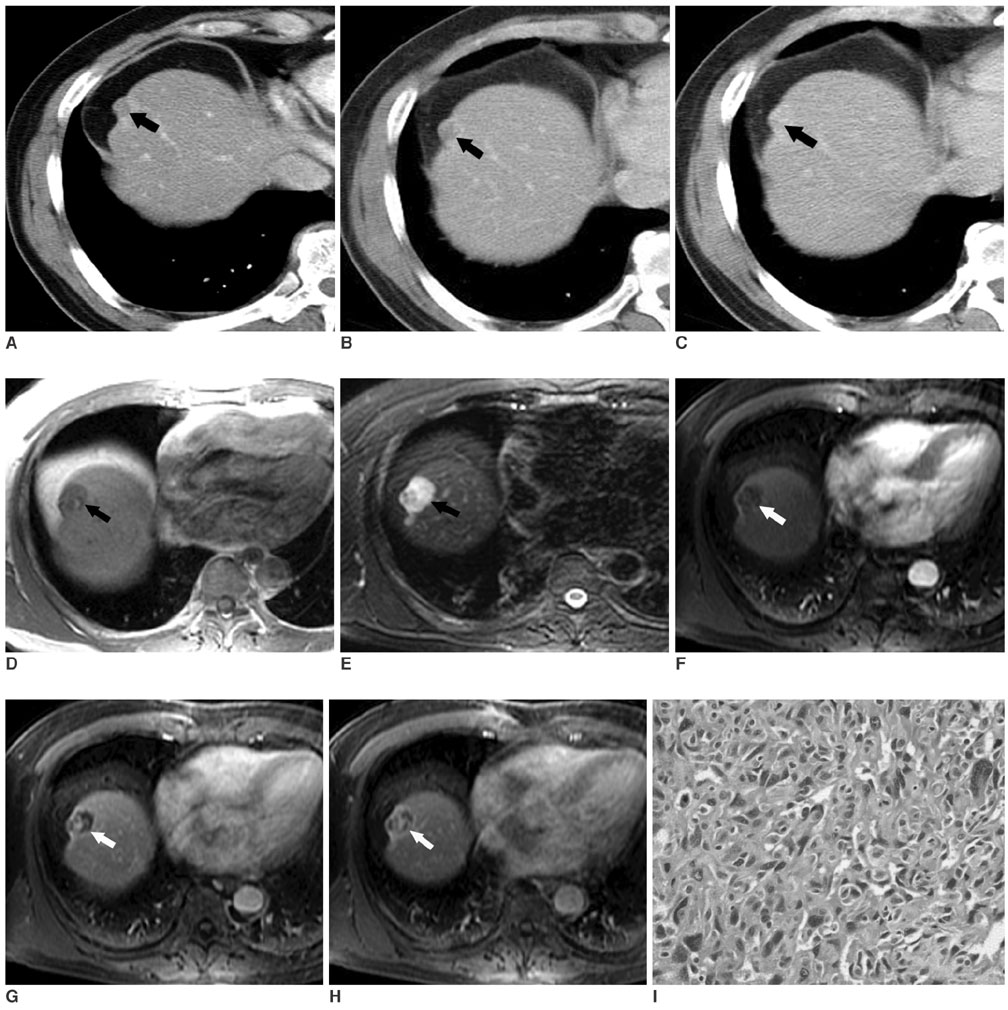Korean J Radiol.
2007 Apr;8(2):180-183. 10.3348/kjr.2007.8.2.180.
Solitary Small Hepatic Angiosarcoma: Initial and Follow-up Imaging Findings
- Affiliations
-
- 1Department of Diagnostic Radiology, Chonnam National University Hwasun Hospital, Hwasun, Korea. yjeong@chonnam.ac.kr
- 2Department of Diagnostic Radiology, Chonnam National University Hospital, Gwangju, Korea.
- KMID: 1126844
- DOI: http://doi.org/10.3348/kjr.2007.8.2.180
Abstract
- We report an uncommon case of solitary, small hepatic angiosarcoma that was initially considered as a hemangioma. We present the imaging findings, with an emphasis on the initial and follow-up CT and MR findings, as well as report on the more suggestive findings of angiosarcoma than those of a hemangioma.
MeSH Terms
Figure
Cited by 1 articles
-
Clinical Courses of Primary Hepatic Angiosarcoma: Retrospective Analysis of Eight Cases
Chang Jae Hur, Bo Ram Min, Yoo Jin Lee, Byung Kuk Jang, Jae Seok Hwang, Eun Soo Kim, Kyung Sik Park, Kwang Bum Cho, Yu Na Kang, Woo Jin Chung
Korean J Gastroenterol. 2015;65(4):229-235. doi: 10.4166/kjg.2015.65.4.229.
Reference
-
1. Buetow PC, Buck JL, Ros PR, Goodman ZD. Malignant vascular tumors of the liver: radiologic-pathologic correlation. Radiographics. 1994. 14:153–166.2. Koyama T, Fletcher JG, Johnson CD, Kuo MS, Notohara K, Burgart LJ. Primary hepatic angiosarcoma: findings at CT and MR imaging. Radiology. 2002. 222:667–673.3. Peterson MS, Baron RL, Rankin SC. Hepatic angiosarcoma: findings on multiphasic contrast-enhanced helical CT do not mimic hepatic hemangioma. AJR Am J Roentgenol. 2000. 175:165–170.4. Itai Y, Teraoka T. Angiosarcoma of the liver mimicking cavernous hemangioma on dynamic CT. J Comput Assist Tomogr. 1989. 13:910–912.5. Ohmoto K, Hirokawa M, Takesue M, Yamamoto S. Hepatic angiosarcoma with early central enhancement and arterioportal shunt on dynamic CT. Hepatogastroenterology. 2000. 47:1717–1718.6. Jones EC, Chezmar JL, Nelson RC, Bernardino ME. The frequency and significance of small (less than or equal to 15 mm) hepatic lesions detected by CT. AJR Am J Roentgenol. 1992. 158:535–539.7. Robinson PJ, Arnold P, Wilson D. Small "indeterminate" lesions on CT of the liver: a follow-up study of stability. Br J Radiol. 2003. 76:866–874.8. Blachar A, Federle MP, Brancatelli G. Hepatic capsular retraction: spectrum of benign and malignant etiologies. Abdom Imaging. 2002. 27:690–699.
- Full Text Links
- Actions
-
Cited
- CITED
-
- Close
- Share
- Similar articles
-
- Primary Colonic Epithelioid Angiosarcoma with Hepatic Metastasis: A Case Report
- Hepatic and splenic angiosarcoma: A case report
- Hepatic Angiosarcoma Mimicking Cavernous Hemangioma on Dynamic CT
- Atypical Angiosarcoma with a Solitary Erythematous Nodule on the Cheek: A Case Report
- A Case Report of Breast Angiosarcoma in a Young Woman


